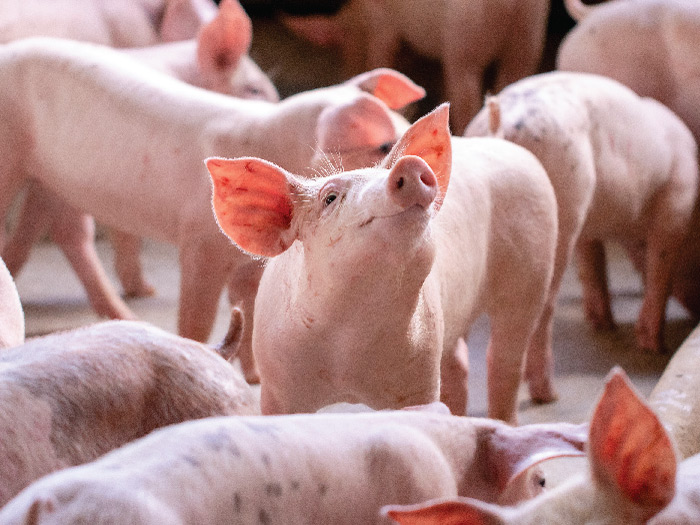
Aujezsky disease –
Pseudorabies (PR)
Disease
The disease is caused by herpesvirus virus (PHV-1 or PRV) that can remain latent in the nervous tissue of the pig for long periods of time, and be reactivated, causing respiratory, reproductive and nervous clinical signs. The virus can survive up to 3 weeks outside the pig. In pregnant sows the virus crosses the placenta and infects piglets.
The pig is the main host. It can affect other species that normally do not transmit the disease, including cows, horses, dogs and cats, which can show nervous symptoms and die. There is no information regarding human infection.1
The are many contributing factors for the disease transmission:
Direct contact, aerosols and airborne transport (long-distance transmission), subclinically infectded pigs, wild boars, contaminated water channels, people, contaminated vehicles, contaminated semen, contaminated slurry, etc. Additionally, the presence of other diseases like PRRS, CSF, or PCV2 can increase the severity of the disease. Among the main PRV existing strains, the reference ones are NIA-4, Bartha and Begonia due to their capability to generate a good immune response when used in a vaccine.

Economic impact
This is a notifiable disease and must be reported to local authorities.

Young swine are highly susceptible, and losses may reach 100% in piglets <7 days old.

Prevalence
Formerly present in many countries, it has been eradicated from some and is notifiable in many.
Despite successful eradication of pseudorabies virus (PRV) from the commercial pig industry in the United States and in some of the most important swine producing countries in Europe around 2003/2004, large populations of feral swine in certain regions act as wildlife reservoirs for the virus. 2
No States (USA) have had recent outbreaks of PRV in commercial production swine. Therefore, all States are currently considered free for PRV and there are no restrictions on the interstate movement of any swine within the United States for this disease.3
The same is true for the European countries after successful eradication.
Pseudorabies has been controlled efficiently in China for many years by vaccination. However, it broke out in many pig farms in 2012-2013 in southern China.4

Diagnosis
This disease affects all age groups. When disease is first introduced into a susceptible breeding herd there are few other diseases except possibly ASF/CSF that would be confused with PRV. Once the disease has become chronic it could be confused with PRRS and chronic classical swine fever. Laboratory tests would be required to differentiate them.5
Acute outbreaks of the disease can happen when a virulent strain affects for the first time a susceptible farm, in which no vaccination against PRV has been practiced.
There are many different clinical signs, depending on the age of the affected animals: sneezing, coughing, fever and malcoordination in piglets, abortions, and reproductive failure in sows. Mortality rate is high in piglets.5
The suspected diagnosis is based on these clinical signs, but should be confirmed by serology, PCR, and virus isolation.
The common laboratory tests are:
- Fluorescent antibody tests on dead piglet tissues particularly tonsils.
- A PCR assay is useful for detection of pseudorabies viral DNA.2
- Serology.
- Virus isolation from the lung and tonsils and its identification.

Treatment and prevention
Since it is slowly transmitted, it can be eradicated through vaccination, good management practices, and elimination of animals that carry the disease.
Control key points1:
- There is no available treatment, but antibiotic use in order to control secondary bacterial infections can be considered.
- Vaccination against PRV must be done when an acute outbreak appears, or as a control or preventive measure (in the EU, vaccination is banned in PRV1 free countries).
- Gilts and boars must be bought from farms free of Aujeszky’s disease and must be vaccinated at their arrival or in the quarantine area.
- Eradication policies can vary from slaughter and repopulation to vaccination and serology.
1. Aujeszky’s disease. Diseases manual. www.pig333.com
2. Sayler KA, et al. Development of a rapid, simple, and specific real-time PCR assay for detection of pseudorabies viral DNA in domestic swine herds. J Vet Diagn Invest. 2017.
3. Oregon Department of Agriculture. United States. July 10, 2020.
4. Gu Z, et al. Emergence of highly virulent pseudorabies virus in southern China. Canadian Journal of Veterinary Research, 2015.
5. Aujezsky’s disease. Disease guide. www.thepigsite.com
Download the disease infographic
MSD Animal Health solutions to control Aujezsky disease

The IDAL Way: Porcilis® Begonia IDAL
ResPig: Porcilis® Begonia is an attenuated live vaccine for the immunization of pigs against Aujezsky’s disease (Pseudorabies) virus infections.
SOLUTIONS
Porcilis® Begonia IDAL
Attenuated live vaccine for the immunization of pigs against Aujeszky’s disease virus infections.


Onset of immunity: 2 weeks
Duration of immunity: 4 months
BENEFITS
- Prevention of clinical signs of PR.
- Prevention of mortality due to PRV infections.
- Reduction of PRV replication.
- Duration of immunity: aprox. 4 months.
HOW TO USE IT
- One intradermal dose of 0.2ml*, from the age of 14 weeks.
- Breeding pigs and eradication schemes: Revaccinations at 4-month intervals, three times yearly as herd vaccination.
- It can be used during pregnancy and lactation.
*There is also an IM version vaccine.



